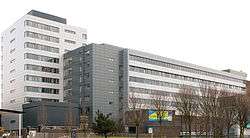Astrophysics Research Institute
|
Liverpool Science Park, the institute's current location | |
| Type | Astronomy and Astrophysics |
|---|---|
| Established | 1992 |
| Director | Professor Chris Collins |
| Location | Liverpool, England |
| Colours |
university colours |
| Affiliations |
Liverpool John Moores University Liverpool Telescope (LT) |
| Website | www.astro.ljmu.ac.uk |
The Astrophysics Research Institute (ARI) is an astronomy and astrophysics research institute located in Merseyside, UK. Formed in 1992, the institute was situated on the Twelve Quays site in Birkenhead from 1998 to 2013, until in June 2013 the institute relocated to the Liverpool Science Park in Liverpool.[1][2] The institute is in the top 1% of institutions in the field of space science as measured by total citations.[3]
There are currently over 60 staff members and research students working at the institute, which lies within the administration of the Liverpool John Moores University's Faculty of Science.[4]
Research
Conducted research varies into many areas of astronomy and astrophysics, such as supernovae, star formation and galaxy clusters. Research is funded by external organisations, such as the Science and Technology Facilities Council,[5] and the Higher Education Funding Council for England.[6] The institute maintains the Liverpool Telescope which is located on the island of La Palma in the Canary Islands.[7]
Education
The institute currently teaches two undergraduate courses: a 3-year BSc (Hons) in Physics and Astronomy, as well as a 4-year MPhys (Hons) in Astrophysics. Both the undergraduate courses are taught as a joint degree by the Astrophysics Research Institute of Liverpool John Moores University and the Department of Physics at the University of Liverpool. The courses are accredited by the Institute of Physics.
Postgraduate courses are made available at PhD and Master's level, with two MSc courses taught via distance learning.[8]
Unaccredited short courses are also made available to those who do not have a scientific or mathematical background. The Astronomy by Distance Learning courses are taught by CD-ROM, DVD and website material without the need for classroom sessions. Each of the courses provides an introduction into astronomy as well as specialist areas such as supernovae.[9]
Awards
In 2006, the institute received the "Queen's Anniversary Prize" for higher education in recognition for its development of the robotic telescope.[10] In 2007 the "Times Higher Education Supplement Award" for 'project of the year' was given for the use of RINGO optical polarimeter at the Liverpool Telescope in measuring gamma-ray bursts. RINGO has since been decommissioned and an updated polarimeter named RINGO2 is since in operation.[11]
Director
| Term | Director |
|---|---|
| 1992–2005 | Professor Mike Bode |
| 2005–2008 | Professor Chris Collins |
| 2008–2014 | Professor Mike Bode |
| 2014–present | Professor Chris Collins |
External links
- LJMU Astrophysics Research Institute - Official Website
- Liverpool John Moores University
References
- ↑ "Astrophysics Research Institute Joins Liverpool Science Park". United Kingdom Science Park Association. Retrieved 4 June 2013.
- ↑ "Astrophysics is moving". 31 May 2013. Retrieved 7 June 2013.
- ↑ "An interview with: Liverpool John Moores University, Astrophysics Research Institute". March 2007. Retrieved 7 June 2013.
- ↑ "Staff at the Astrophysics Research Institute". Retrieved 7 June 2013.
- ↑ "STFC Grants on the Web: Institution analysis". Stfc.ac.uk. 15 October 2012. Archived from the original on 19 March 2012. Retrieved 2012-10-20.
- ↑ "Astrophysics Research Institute - Liverpool John Moores University". Astro.ljmu.ac.uk. Retrieved 2012-10-20.
- ↑ "Liverpool Telescope". Retrieved 2012-03-03.
- ↑ "Astrophysics MSc". Retrieved 2016-09-23.
- ↑ "Courses". Retrieved 2016-09-23.
- ↑ "UK | England | Merseyside | Royal recognition for university". BBC News. 2006-02-15. Retrieved 2012-10-20.
- ↑ "The Liverpool Telescope: News : Archive : s20071205". Telescope.livjm.ac.uk. 2007-12-05. Retrieved 2012-10-20.
